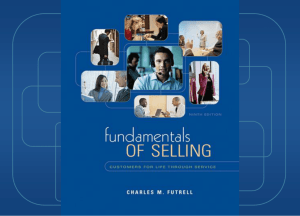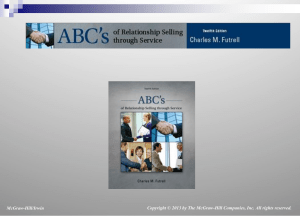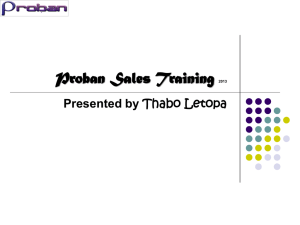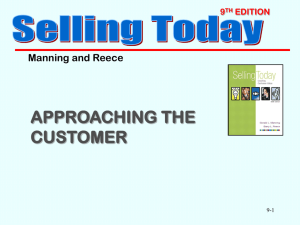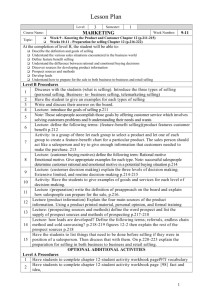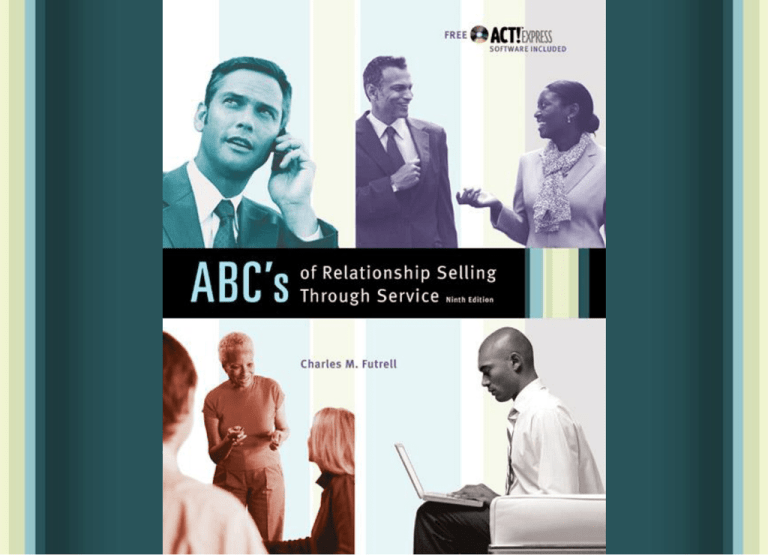
Begin Your Presentation
Strategically
McGraw-Hill/Irwin
Copyright © 2007 by The McGraw-Hill Companies, Inc. All rights reserved.
Chapter
9
9-3
Chapter
9
Main Topics
9-4
The Tree of Business Life: The Beginning
What is the Approach?
The Right to Approach
The Approach—Opening the Sales Presentation
Technology in the Approach
Chapter
9
Main Topics
9-5
Is the Approach Important?
Using Questions Results in Sales Success
Is the Prospect Still Not Listening?
Be Flexible in Your Approach
Chapter
9
The Tree of Business Life: The Beginning
T
T T
T T TT
T T T T
Builds
Guided by The Golden Rule:
Begin the presentation with an
Relationships
9-6
end in mind.
Seek first to understand, then
to be understood.
Show great caring, confidence,
and excitement in your mind,
body, and speech by knowing
you can help solve problems.
Do not give in to the temptation
to exaggerate.
You will see that trust, integrity,
and character win out in the
long run.
What Is the Approach?
A golf shot from the fairway toward the green
Steps a bowler takes
before delivering the
bowling ball
9-7
For the Salesperson What Is the
Approach?
The time from when the salesperson first sees
the buyer to the beginning of the discussion of
the product
9-8
The Approach
Could last seconds or minutes and involves:
Meeting
Greeting
Rapport Building
One of the approach communication techniques
discussed in this chapter
9-9
The Approach Is:
The 1st step in the sales presentation
The 3rd step in the selling process
9-10
Exhibit 9-1: The Approach Begins the Sales
Presentation
The sales presentation method
determines how you open your
presentation.
9-11
Select Your Presentation Method and Then
Your Approach
Approach
Presentation
9-12
Caution Salespeople
Take the approach seriously.
Some feel this is the most important step in
helping someone
If unsuccessful, you may never have
opportunity to move into the presentation.
If you can not tell your story how will you
make the sale?
The approach is extremely important.
9-13
The Approach Step of the Sales
Presentation
Is over when you begin discussing the product
itself
9-14
Let’s Summarize! The Salesperson:
Meets
Greets
Builds rapport
Goes through the approach
Discusses the product
Discusses the marketing plan
Discusses the business proposition
Closes – asks for the order
9-15
The Right to Approach
You have to prove you are worthy of the
prospect’s time and serious attention by:
Exhibiting specific product or business knowledge
Expressing a sincere desire to solve the buyer’s
problem and satisfy a need
Stating or implying that your product will save
money or increase the firm’s profit margin
Displaying a service attitude
9-16
The Approach–Opening the Sales
Presentation
A buyer’s reactions to the salesperson in the
early minutes of the presentation are critical to
a successful sale.
Your attitude during the approach:
It is common for a salesperson to experience
tension in various forms when contacting a
prospect.
Successful salespeople have learned to use
creative imagery to relax and concentrate.
9-17
The First Impression You Make Is Critical to
Success
Your first impression is projected by:
Appearance
Attitude
You only have one chance to make
a favorable first impression.
9-18
Exhibit 9-4: Five Ways to Remember
Prospect’s Name
1. Be sure to hear the person’s name and use it: “It’s good to meet you, Mr. Firestone.”
2. Spell it out in your mind, or if it is an unusual name, ask the person to spell the
name.
3. Relate the name to something you are familiar with, such as relating the name
Firestone to Firestone automobile tires or a hot rock.
4. Use the name in conversation.
5. Repeat the name at the end of the conversation, such as “Goodbye, Mr. Firestone.”
9-19
To Make a Favorable Impression:
Wear business clothes that are suitable and
fairly conservative.
Be neat in dress and grooming.
Refrain from smoking, chewing gum, or
drinking in your prospect’s office.
Keep an erect posture.
Leave all unnecessary materials outside the
office.
If possible, sit down.
9-20
To Make a Favorable Impression, cont…
Be enthusiastic and positive toward the interviewer.
Smile!
Do not apologize for taking the prospect’s time.
Do not imply that you were just passing by.
Maintain eye contact.
If the prospect offers to shake hands, do so with a
firm, positive grip while maintaining eye contact.
Learn how to pronounce the prospect’s name
correctly.
9-21
Approach Techniques and Objectives
Opening with a statement
Opening with a demonstration
Opening with a question or questions
9-22
Exhibit 9-5: The Approach Techniques for
Each of the Four Sales Presentation Methods
9-23
Objectives of Both Statement and
Demonstration Approach Techniques
Attention
Interest
Transition
9-24
The Situational Approach
The situation you face determines which
approach technique you use.
Influences on the approach to use include:
Product being sold
Whether the call is a repeat call
Customer’s needs
Amount of time
Awareness of a problem
9-25
The Approach Leads Quickly Into the Sales
Presentation
9-26
Objectives Of Using Question Approach
Techniques
Uncover needs and problems:
Fulfill needs
Solve problems
Have prospect tell you about:
Needs
Problems
Intention to do something about them
9-27
Exhibit 9-6: Approach Techniques for
Opening the Presentation
9-28
The Golden Rule
Follow the Golden Rule by placing the other
person’s interest before your self-interest.
This will avoid:
Losing the Sale
Destroying your business relationship
9-29
Opening With Statements
Introductory approach
Complimentary approach
Referral approach
Premium approach
9-30
Demonstration Openings
Product approach
Showmanship approach
9-31
Opening With Questions
Most common openers:
Customer benefit approach
Curiosity approach
Opinion approach
Shock approach
9-32
Exhibit 9-10: A Popular Multiple-Question
Approach Is the Spin
Remember,
the product
is not
mentioned in
SPIN.
Skip video
9-33
To pause the video, click on the video screen. To resume
play, click on the video screen again. Click outside the
video screen twice to advance to the next slide.
Technology in the Approach
Powerful attention-grabbers:
Sounds
Visuals
Touch
9-35
Is the Approach Important?
Yes it is!
Salespeople need several approach
techniques that have worked in the past to
select the approach for a current situation.
9-36
Remember to Select Your Presentation
Method and Then Your Approach
Approach
Presentation
9-37
Using Questions Results in Sales Success
1. The direct question
2. The nondirective question
3. The rephrasing question
4. The redirect question
9-38
The Direct Question
Can be answered with a few words such as:
“Mr. Jones, is reducing manufacturing costs
important to you?”
“What kind?”
“How many?”
Never phrase as a direct negative or a
question that can cut you off
Example: “May I help you?”
9-39
The Direct Question Limitations
Does not really tell you much
There is little feedback information
9-40
The Nondirective (Open-Ended) Question
Begins with who, what, where, when, how,
or why:
“Who will use this product?”
“What features are you looking for in a product
like this?”
Its purpose is to obtain unknown or
additional information
9-41
The Rephrasing Question
Is useful if you are unclear and need to clarify
the meaning of something said:
“Are you saying that price is the most important
thing you are interested in?”
“Then what you are saying is, if I can improve the
delivery time, you would be interested in buying?”
9-42
The Redirect Question
Used to change the direction of the conversation –
often from a negative to a positive
Imagine you walk into a prospect’s office, introduce
yourself, and get this response:
“I’m sorry, but there is no use in talking. We are satisfied with
our present suppliers. Thanks for coming by.”
A redirect question would be:
“Wouldn’t you agree that you continually need to find new
ways to increase your company’s sales?”
9-43
Three Rules for Using Questions
1. Use only questions that you can anticipate
the answer to or that will not lead you into a
situation from which you cannot escape
2. Pause or wait after submitting a question
3. Listen
9-44
Is the Prospect Still Not Listening?
This is the time to use an alternative opener
that forces the prospect to participate by using
the:
Question approach
Demonstration approach
The salesperson who can deftly capture
another person’s imagination earns the right
to a prospect’s full attention and interest.
9-45
Be Flexible in Your Approach
Be willing and ready to change your planned
approach.
That is why you need several methods to
open your sales presentation
Skip video
9-46
To pause the video, click on the video screen. To resume
play, click on the video screen again. Click outside the
video screen twice to advance to the next slide.
Summary of Major Selling Issues
The approach is the critical factor.
Use a statement or demonstration approach
to ensure your prospect’s attention and
interest.
The first impression you make can negate
your otherwise positive and sincere opening.
Open with a statement, question, or
demonstration.
9-48
Summary of Major Selling Issues, cont…
Questions should display a sincere interest in
prospects and their situations.
The four basic types of questions are direct,
nondirective, rephrasing, and redirect.
Allow prospects time to completely answer the
question.
9-49
End of Chapter 9
McGraw-Hill/Irwin
Copyright © 2007 by The McGraw-Hill Companies, Inc. All rights reserved.
Chapter
9

